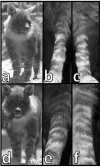The value of individual identification in studies of free-living hyenas and aardwolves
- PMID: 36530605
- PMCID: PMC9744671
- DOI: 10.1007/s42991-022-00309-4
The value of individual identification in studies of free-living hyenas and aardwolves
Abstract
From population estimates to social evolution, much of our understanding of the family Hyaenidae is drawn from studies of known individuals. The extant species in this family (spotted hyenas, Crocuta crocuta, brown hyenas, Parahyaena brunnea, striped hyenas, Hyaena hyaena, and aardwolves, Proteles cristata) are behaviorally diverse, presenting an equally diverse set of logistical constraints on capturing and marking individuals. All these species are individually identifiable by their coat patterns, providing a useful alternative to man-made markings. Many studies have demonstrated the utility of this method in answering a wide range of research questions across all four species, with some employing a creative fusion of techniques. Despite its pervasiveness in basic research on hyenas and aardwolves, individual identification has rarely been applied to the conservation and management of these species. We argue that individual identification using naturally occurring markings in applied research could prove immensely helpful, as this could further improve accuracy of density estimates, reveal characteristics of suitable habitat, identify threats to population persistence, and help to identify individual problem animals.
Supplementary information: The online version contains supplementary material available at 10.1007/s42991-022-00309-4.
Keywords: Aardwolf; Camera traps; Carnivores; Hyena; Individual identification; Mark-recapture.
© The Author(s) under exclusive licence to Deutsche Gesellschaft für Säugetierkunde 2022, Springer Nature or its licensor (e.g. a society or other partner) holds exclusive rights to this article under a publishing agreement with the author(s) or other rightsholder(s); author self-archiving of the accepted manuscript version of this article is solely governed by the terms of such publishing agreement and applicable law.
Conflict of interest statement
Conflict of interestOn behalf of all authors, the corresponding author states that there is no conflict of interest.
Figures










References
-
- Abay GY, Bauer H, Gebrihiwot K, Deckers J. Peri-urban spotted hyena (Crocuta crocuta) in northern Ethiopia: diet, economic impact, and abundance. Eur J Wildl Res. 2011;57:759–765. doi: 10.1007/s10344-010-0484-8. - DOI
-
- AbiSaid M, Dloniak SMD (2015) Hyaena hyaena. The IUCN Red List of Threatened Species. 10.2305/IUCN.UK.2015-2.RLTS.T10274A45195080.en. Accessed 10 Dec 2020
-
- Akçakaya HR, Butchart SHM, Mace GM, Stuart SN, Hilton-Taylor C. Use and misuse of the IUCN Red List Criteria in projecting climate change impacts on biodiversity. Glob Change Biol. 2006;12:2037–2043. doi: 10.1111/j.1365-2486.2006.01253.x. - DOI
-
- Alam MS, Khan JA, Pathak BJ. Striped hyena (Hyaena hyaena) status and factors affecting its distribution in the Gir National Park and Sanctuary, India. J Vertebr Biol. 2015;64:32–39. doi: 10.25225/fozo.v64.i1.a4.2015. - DOI
-
- Alam MS (2011) Status ecology and conservation of striped hyena (Hyaena hyaena) in Gir National Park and Sanctuary, Gujarat. Dissertation, Aligarh Muslim University
Publication types
LinkOut - more resources
Full Text Sources
